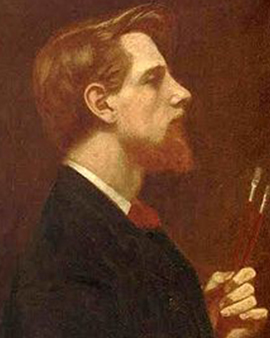In the venerable halls of British art history, Thomas Cooper Gotch (b. December 10, 1854; † May 1, 1931) is firmly enshrined as an enthusiastic exponent of Late Impressionism, Symbolism, and Pre-Raphaelism. This highly talented painter was also an important pillar of the Newlyn School, an artists' colony that vigorously churned the waves of the art world in the late 19th and early 20th centuries with its creative spirit. Gotch's life's journey is an ode to the ceaseless artistic spirit, a trail of light and color that stretches from Kettering, Northamptonshire to Newlyn, Cornwall. His artistic odyssey began in the heart of England, in a wealthy, unconventional family in Kettering. He followed his heart and the muse to Heatherley's Art School, the Koninklijke Academie voor Schone Kunsten in Antwerp, and finally the Slade School of Fine Art in London. During his studies, he crossed paths with Henry Scott Tuke, a future life friend, and Caroline Burland Yates, his future wife and constant companion on the journey of creative work.
Gotch's story is one that strikes at the heart of art and culture, from teaching the craft to local youth in the Newlyn Industrial Classes, to co-founding the rebellious New English Art Club in the wild days of resistance to the Royal Academy of Arts' conservative approach to art. His unique talent for outdoor painting contributed to the creation of outstanding fine art prints of realistic and late impressionist oil paintings and watercolors that defined the era. A turning point in his artistic career was initiated by a stay in Florence, the cradle of the Renaissance. Here a profound transformation in his artistic style took place, reflected in his works by a strong orientation towards the Pre-Raphaelites and the absorption of Symbolism and Romanticism. Despite initial rejection, his works such as "The Child Enthroned" and "Alleluia" eventually received widespread recognition and are now among the most iconic works of art of the Victorian era.
Gotch was also a notable portrait painter who focused on depicting young girls, bringing a modern touch to the art scene of the time. He continued to devote himself to realism painting until his death in 1931, leaving behind a considerable artistic legacy that can now be found in prestigious galleries and museums such as the Alfred East Gallery in Kettering and the Victoria and Albert Museum in London. With our art prints of Gotch's works, we want to honor his artistic legacy and bring his unique style to the world. Each art print is made with the utmost care and precision to perfectly reproduce the details and color nuances of his artwork, bringing his creative spirit to life. Indeed, each piece carries the touch of the Victorian era, captured by the careful brushstrokes of an incomparable artist. This is our tribute to Thomas Cooper Gotch, an artist whose passionate and unrelenting contribution to the art world has secured him a permanent place in the annals of British art history. In contemplating his works, one can experience the joy and sublimity of creative work, as well as the intimacy and uniqueness of each moment he captured.
×





.jpg)
.jpg)
.jpg)
.jpg)
.jpg)
.jpg)
.jpg)
.jpg)
.jpg)
.jpg)
.jpg)
.jpg)
.jpg)
.jpg)
.jpg)
.jpg)
_-_(MeisterDrucke-1128211).jpg)
_-_(MeisterDrucke-1128211).jpg)
.jpg)
.jpg)
.jpg)
.jpg)
.jpg)
.jpg)
.jpg)
.jpg)
.jpg)
.jpg)
.jpg)
.jpg)
.jpg)
.jpg)
.jpg)
.jpg)
.jpg)
.jpg)
.jpg)
.jpg)
.jpg)
.jpg)
.jpg)
.jpg)
.jpg)
.jpg)
_-_(MeisterDrucke-937154).jpg)
_-_(MeisterDrucke-937154).jpg)
.jpg)
.jpg)
.jpg)
.jpg)
.jpg)
.jpg)
.jpg)
.jpg)
.jpg)
.jpg)
.jpg)
.jpg)
.jpg)
.jpg)
_-_(MeisterDrucke-1640816).jpg)
_-_(MeisterDrucke-1640816).jpg)
.jpg)
.jpg)
.jpg)
.jpg)
.jpg)
.jpg)
_-_(MeisterDrucke-1129033).jpg)
_-_(MeisterDrucke-1129033).jpg)
.jpg)
.jpg)
_-_(MeisterDrucke-1131640).jpg)
_-_(MeisterDrucke-1131640).jpg)
.jpg)
.jpg)
.jpg)
.jpg)
 - (MeisterDrucke-277718).jpg)
 - (MeisterDrucke-277718).jpg)
 - (MeisterDrucke-287760).jpg)
 - (MeisterDrucke-287760).jpg)
.jpg)
.jpg)
_-_(MeisterDrucke-1123141).jpg)
_-_(MeisterDrucke-1123141).jpg)
_-_(MeisterDrucke-1010662).jpg)
_-_(MeisterDrucke-1010662).jpg)
_-_(MeisterDrucke-907352).jpg)
_-_(MeisterDrucke-907352).jpg)
.jpg)
.jpg)
.jpg)
.jpg)
.jpg)
.jpg)
_-_(MeisterDrucke-1130777).jpg)
_-_(MeisterDrucke-1130777).jpg)
.jpg)
.jpg)
_-_(MeisterDrucke-1113212).jpg)
_-_(MeisterDrucke-1113212).jpg)






